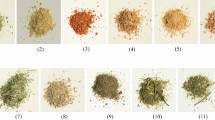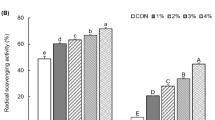Abstract
Ginger and garlic have long been used in Asian countries to enhance the flavor and to neutralize any unpleasant odors present in fish soup. The purpose of this study was to evaluate the change in the amount of volatile components present in fish soup compared to boiled water solutions of ginger and garlic. The fish soup was prepared by boiling oil-fried grass carp (Ctenopharyngodon idella) with or without ginger and/or garlic. Generally, boiling garlic and ginger in water led to a decrease in the amount of the principal volatile constituents of these spices, together with the formation of some new volatiles such as pentanal, hexanal, and nonanal. The results showed that 16 terpenes present in raw ginger, predominantly camphene, β-phellandrene, β-citral, α-zingiberene, and (E)-neral, were detected in fish soup with added ginger and thus remained in the solution even after boiling. Similarly, 2-propen-1-ol and three sulfur compounds (allyl sulfide, diallyl disulfide, and diallyl trisulfide) present in raw garlic, were present in trace amounts in the boiled garlic solution, but were present in considerably larger amounts in the boiled fish solution with garlic or garlic plus ginger. In conclusion, the effect of adding spices on the volatile profile of grass carp soup can be attributed to the dissolution of flavor volatiles mainly derived from raw spices into the solution, with few additional volatiles being formed during boiling. In addition, boiling previously fried grass carp with spices led to enhanced volatile levels compared to boiled spice solutions.
Similar content being viewed by others
References
Acree T, Arn H (2015) Flavornet and human odor space. http://www.flavornet.org/flavornet.html. Accessed 20 Sept 2015
Aminifar M, Hamedi M, Emam-Djomeh Z, Mehdinia A (2014) Investigation on proteolysis and formation of volatile compounds of Lighvan cheese during ripening. J Food Sci Technol 51:2454–2462
Bartley JP, Jacobs AL (2000) Effects of drying on flavour compounds in Australian-grown ginger (Zingiber officinale). J Sci Food Agric 80:209–215
Chevance FF, Farmer LJ (1999) Identification of major volatile odor compounds in frankfurters. J Agric Food Chem 47:5151–5160
Chu-Chin C, Chi-Tand H (1987) Gas chromatographic analysis of thermal degradation products of gingerol compounds in steam-distilled oil from ginger (Zingiber officinale Roscoe). J Chromatogr A 387:499–504
Chyau C-C, Mau J-L (1999) Release of volatile compounds from microwave heating of garlic juice with 2,4-decadienals. Food Chem 64:531–535
Dhanya K, Sasikumar B (2010) Molecular marker based adulteration detection in traded food and agricultural commodities of plant origin with special reference to spices. Curr Trends Biotechnol Pharm 4:454–489
Hamm S, Lesellier E, Bleton J, Tchapla A (2003) Optimization of headspace solid phase microextraction for gas chromatography/mass spectrometry analysis of widely different volatility and polarity terpenoids in olibanum. J Chromatogr A 1018:73–83
Hirasa K, Takemasa M (1998) Spice science and technology. Marcel Dekker, Inc., New York
Kasahara K, Osawa C (1998) Combination effects of spices on masking of odor in boiled sardine. Fish Sci 64:415–418
Kawai T, Sakaguchi M (1996) Fish flavor. Crit Rev Food Sci Nutr 36:257–298
Kikuchi T, Hirai K, Sudarso AS (1968) Suppressing effect of spice for fishy odor: a model experiment with the mixture of trimethylamine and spice. Eiyo to Shokuryo 21:253–256
Kim SM, Wu CM, Kubota K, Kobayashi A (1995) Effect of soybean oil on garlic volatile compounds isolated by distillation. J Agric Food Chem 43:449–452
Kim NY, Park MH, Jang EY, Lee J (2011) Volatile distribution in garlic (Allium sativum L.) by solid phase microextraction (SPME) with different processing conditions. Food Sci Biotechnol 20:775–782
Lee S, Woo Y, Kyung KH (2006) Allyl alcohol found in heated garlic is a potent selective inhibitor of yeasts. J Microbiol Biotechnol 16:1236
Leffingwell Associates (2012) Flavor-base, 9th edn (Demo), Leffingwell & Associates. http://www.leffingwell.com/boronia.htm
Linstrom PJ, Mallard W (2001) NIST chemistry webbook, NIST standard reference database No. 69. http://webbook.nist.gov/chemistry/. Accessed 20 Sept 2015
Luebke W (2016) Perflavory. http://www.perflavory.com/index.html. Accessed 8 Feb 2016
Meilgaard MC (1975) Flavor chemistry of beer. I. Flavor interaction between principal volatiles. MBAA Technical Quarterly 12:107–117
Morita K, Kubota K, Aishima T (2003) Comparison of aroma characteristics of 16 fish species by sensory evaluation and gas chromatographic analysis. J Sci Food Agric 83:289–297
Raghavan S (2006) Handbook of spices, seasonings, and flavorings. CRC Press, Taylor & Francis Group, Boca Raton, New York
Rattan S, Parande A, Ramalakshmi K, Nagaraju V (2015) Effect of edible coating on the aromatic attributes of roasted coffee beans. J Food Sci Technol 52:5470–5483
Schutte L, Teranishi R (1974) Precursors of sulfur-containing flavor compounds. Crit Rev Food Sci Nutr 4:457–505
Schweiggert U, Carle R, Schieber A (2007) Conventional and alternative processes for spice production—a review. Trends Food Sci Technol 18:260–268
Shukla Y, Singh M (2007) Cancer preventive properties of ginger: a brief review. Food Chem Toxicol 45:683–690
Simpson R (1979) Some important aroma components of white wine. Food Technol Aust 31:516–522
Suffet IM, Khiari D, Bruchet A (1999) The drinking water taste and odor wheel for the millennium: beyond geosmin and 2-methylisoborneol. Water Sci Technol 40:1–13
Van den Dool H, Kratz PD (1963) A generalization of the retention index system including linear temperature programmed gas–liquid partition chromatography. J Chromatogr A 11:463–471
Van Lancker F, Adams A, Owczarek-Fendor A, De Meulenaer B, De Kimpe N (2010) Mechanistic insights into furan formation in Maillard model systems. J Agric Food Chem 59:229–235
Variyar PS, Gholap A, Thomas P (1997) Effect of γ-irradiation on the volatile oil constituents of fresh ginger (Zingiber officinale) rhizome. Food Res Int 30:41–43
Wardencki W, Michulec M, Curyło J (2004) A review of theoretical and practical aspects of solid-phase microextraction in food analysis. Int J Food Sci Technol 39:703–717
Xiong Q, Hu T, Zhao S, Huang Q (2015) Texture and flavor characteristics of rice cake fermented by Brettanomyces custersii ZSM-001. J Food Sci Technol 52:1–10
Yaylayan V (2006) Precursors, formation and determination of furan in food. Journal für Verbraucherschutz und Lebensmittelsicherheit 1:5–9
Yoshida A, Sasaki K, Ohshiba K (1984) Suppressing experiments for fishy odor. II. Effects of spices, seasonings and food additives for fishy odor and volatile carbonyl compounds. Seikatsu Esei 28:211–218
Zakipour Rahimabadi E, Bakar J, Che Man Y, Abdul Hamid N, Arshadi A (2011) The impact of lipid content, cooking and reheating on volatile compounds found in Narrow—barred Spanish mackerel (Scomberomorous commerson). Iran J Fish Sci 10:336–345
Zhang J, Wu D, Liu D, Fang Z, Chen J, Hu Y, Ye X (2013) Effect of cooking styles on the lipid oxidation and fatty acid composition of grass carp (Ctenopharynyodon idellus) fillet. J Food Biochem 37:212–219
Acknowledgments
This work was supported by the Earmarked Fund for Jiangxi Agriculture Research System (JXARS-04) and the Collaborative Innovation Center for Major Ecological Security Issues of Jiangxi Province and Monitoring Implementation (No. JXS-EW-00).
Author information
Authors and Affiliations
Corresponding author
Ethics declarations
Conflict of interest
None.
Rights and permissions
About this article
Cite this article
Li, Jl., Tu, Zc., Zhang, L. et al. The effect of ginger and garlic addition during cooking on the volatile profile of grass carp (Ctenopharyngodon idella) soup. J Food Sci Technol 53, 3253–3270 (2016). https://doi.org/10.1007/s13197-016-2301-1
Revised:
Accepted:
Published:
Issue Date:
DOI: https://doi.org/10.1007/s13197-016-2301-1




